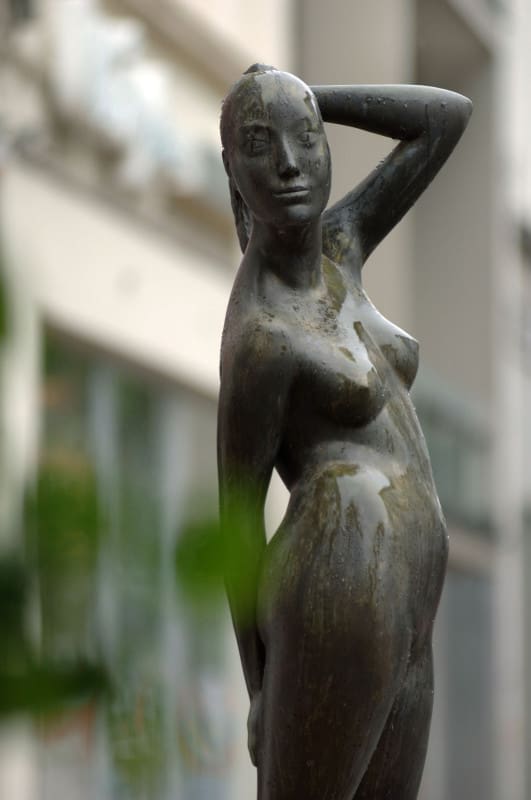TINE (LODE EYCKERMANS)
In the immediate vicinity of ‘Najade’ (by Alphons Darville) the street is embellished by ‘Zangertje (Little Singer)’ - 1942, and ‘Tine’ - 1960, both by Lode Eyckermans. It is interesting to compare the two statues in function of the style evolution they illustrate.
Looking at ‘Tine’ one notices the expressive resilience of its shape. The body bowing to the right and head slightly turned, the statue presents a sensual elegance. She is holding up her left arm while her right arm rests on the back.
Lode Eyckermans donated both statues, ‘Zangertje’ and ‘Tine’ to Kunst in de Stad.. ‘Tine’ apparently was a renowned ‘model’ in the Antwerp arts scene. The artist himself named the sculpture ‘La Giapponese’. The work dates from 1960 and, according insiders, belongs to the sculptural group ‘Dansende Muzen (Dancing Muses)’.
Tormented by hatred because of his war captivity during the second World War, Eyckermans’ work focussed on the theme of love, whereby he did not shun erotic expressions.
Originally Eyckermans created mainly realistic, solitary figures in a typical classic posture.
His work also includes subjects as death, mother and child and self-portraits.
In 1952 Eyckermans works for some months in Italy. There he meets Henry Moore, whose work clearly influences him. This is apparent in his subsequent works.
In the seventies Eyckermans reverts to solitary figures, albeit in a more abstract design, sometimes with humour and sarcasm. Later still he evolves towards a stylised, futuristic style, while still adhering to the organic aesthetics.
EYCKERMANS Lode (1919-1998)
Born and deceased in Antwerpen. Schooled by Frans Huygelen, Ernest Wijnants and Henri Puvrez at the Higher Institute of Antwerpen. Becomes a teacher at the Academies of Antwerpen and Mechelen in 1949. From 1975 to 1983 he is head of the Academy for Free Visual Arts in Mechelen. His first important exhibition is the Quadrennial in Liège in 1939. He wins several awards, among which the ‘Grote Prijs van de stad Antwerpen’ (1936); the 'Van Leriusprijs’ for sculpture (1941); the 'Godecharleprijs' (1942) and the ‘Prijs van Rome’ (1943), this last award gives him the opportunity to go and work in Rome for a year.
Kunst in de Stad – June 15th 1991

